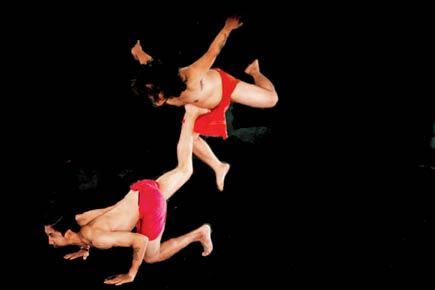Amid the stunning artistry in Manipuri productions, there’s always an overt or covert hint of the socio-political situation of the state


Actors perform in Surjit Nongmeikapam’s dance drama, Nerves. Pic/Chaoba Thiyam
ADVERTISEMENT
 There’s a scene in the recent Bollywood film Pink, in which a young woman who looks North-Eastern (played by Andrea Tariang), is asked by the lawyer if she is from Manipur.
There’s a scene in the recent Bollywood film Pink, in which a young woman who looks North-Eastern (played by Andrea Tariang), is asked by the lawyer if she is from Manipur.
“Meghalaya,” she replies. The lawyer looks as if he couldn’t care less, it’s all the same to him. The smirk on his fact suggests that he thinks girls from the North East are of questionable morals. But Andrea has been traumatised by the way men look at her in the streets of Delhi, precisely because of this horrible, racist and sexist misconception.
By and large, there is ignorance about the region. If all Manipur rings a louder bell, it is perhaps because of Irom Sharmila and her fight against the Armed Forces (Special Powers) Acts (AFSPA) — a colonial remnant that continues to victimise the people of Manipur (and other N-E states).
In spite of all its political turmoil, Manipur has a rich cultural life, a beautiful classical dance form, vibrant folk music, and some of India’s theatre greats — Ratan Thiyam, Heisnam Kanhailal and Lokendra Arambam, to name just three — hail from there. However, their work travels to Mumbai so infrequently, that very few people have seen their marvellous productions. Still, in their stunning artistry, there is an overt or covert hint of the socio-political situation in the state.
Nerves, the dance drama by Surjit Nongmeikapam, that won the Prakriti Foundation’s award for Excellence in Contemporary Dance in 2014, has to be seen keeping in mind the turbulence in the state the suffering of the people. (The nude protest by the women of Manipur in 2004 is unforgettable in its vehemence.)
The performance begins with an idyllic setting with lamps glowing in the dark. Then a human figure writhes in the dim light. This stillness gives way to a robust folk style dance. Then the dancers, dressed in red loincloths made of that distinctive Manipuri weave, wear army boots, their movements becoming aggressive and martial. The boots become a symbol of oppression, as they are later used to attack a woman, and swung from the end of a rope like a lasso, as the dancers contort their bodies to escape being hit.
The most disturbing scene is the one in which the only woman in the group is attacked by the men with bamboo sticks (the sticks are also a recurring motif), in a long, horrifically brutal sequence. It actually makes one wonder how, to portray violence against women, the performers could inflict such indignity against a female member of the troupe.
The performance ends with the dancers wrapped in red yarn from a loom and shuddering as if they were in sync with the movement of the weaver, perhaps also portraying the bloodshed the people have had to suffer.
In his programme note, Nongmeikapam, who is also a dance therapist, trained in kalaripayattu, kathak, Manipuri dance and Thang-Ta, states, “My initial research was on the people of Manipur. Given that Manipur is one of the most culturally diverse states in the country and one of the most conflicted zones, my focus was on the numerous issues the people are faced with. Personal experiences varied and left strong physical and mental impacts on Manipur’s people. When creating Nerves, the first thing that came to my mind was Manipur’s youth, her dancers, movers, musicians and non-dancers as my performers. Rather than focusing on dance technique, the idea was to focus on shedding light on the disturbed senses from the inner self. Therefore, the movement in Nerves is raw and strong. All performers are first timers in the contemporary dance field. Nerves has thus been a challenge for me as a choreographer.”
It does come as a surprise that the dancers (Purnima Yegkokpam, Senjam Hemjit Meitei, Laiphamgbam Suraj Roy, Sumeet Sagolsem, Suresh Kiran Singh Khundrakpam) are first-timers. Their lithe bodies and unflagging energy was amazing. Even while admiring the dancers, and the imagery of relentless violence, one does wonder if that is all there is to Manipur. Amidst that anger and pain, isn’t their even a smidgen of hope or beauty?
The Manipur Times called Nongmeikapam the “new hotstepper of India”, writing, “It’s not something one would imagine coming from a kid who spent hours at his grandfather’s video parlour watching Bollywood films and choreographing not dances but fight sequences to emulate his idol, Jackie Chan. Bonbon’s fondness of climbing and jumping off walls ensured that he had athleticism and flexibility — skills which would later help him take up dance professionally.” His career graph has been quite remarkable and it is clear that he is the young artistic voice of Manipur.
The group has won the Excellence in Contemporary Dance award again in 2016, and will probably return with their new work next year.
Deepa Gahlot is an award-winning film and theatre critic and an arts administrator. She tweets @deepagahlot. Send your feedback to mailbag@mid-day.com
 Subscribe today by clicking the link and stay updated with the latest news!" Click here!
Subscribe today by clicking the link and stay updated with the latest news!" Click here!






